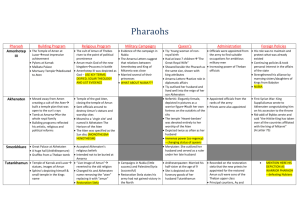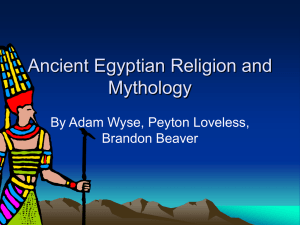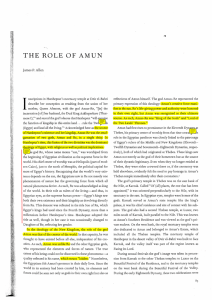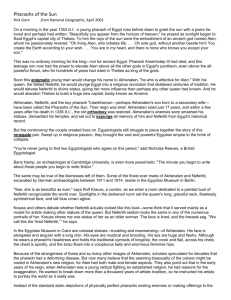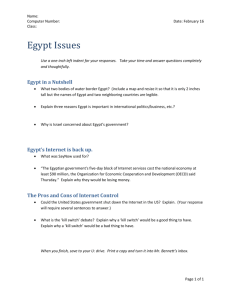File - My Life through Learning
advertisement
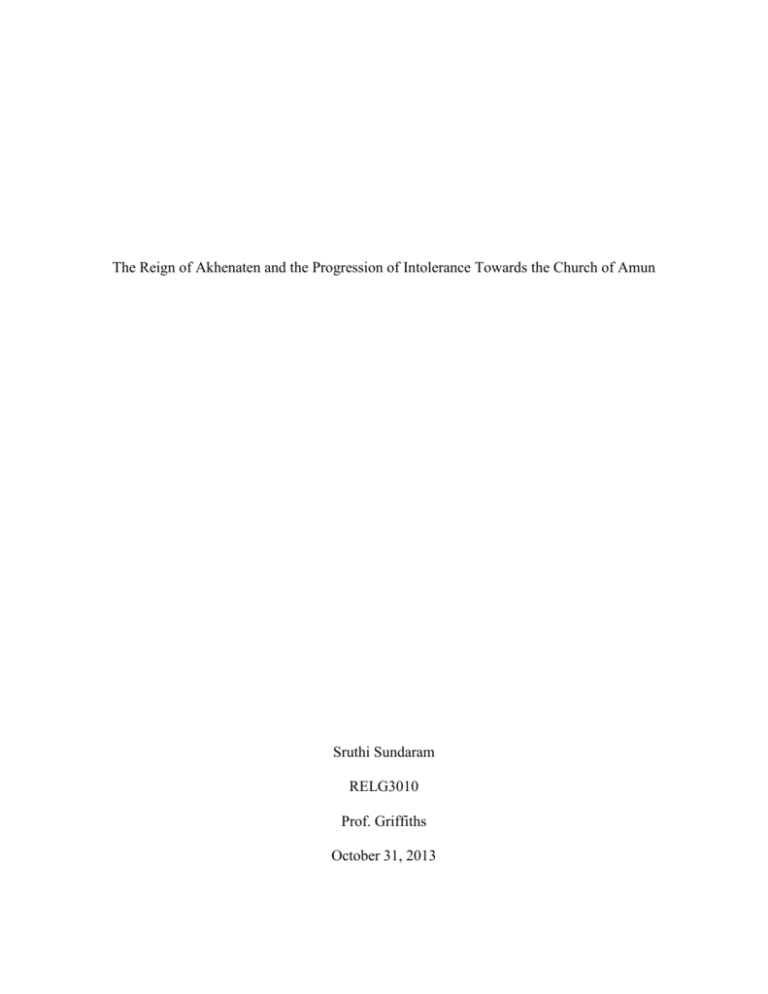
The Reign of Akhenaten and the Progression of Intolerance Towards the Church of Amun Sruthi Sundaram RELG3010 Prof. Griffiths October 31, 2013 The Egyptian religion during the reign of the New Kingdom (1539-1070 BCE) was centered on the worship of a solar deity along with other gods who served as symbols for the solar deity’s power and magnificence (Montserrat viii). The ‘solar deity’ or ‘sun god’ is a term that should, in truth, be referred to in the plural as there were several deities attributed to the sun in the Egyptian religion. The most prominent, supreme sun god was Ra, whose various aspects were embodied by localized forms. Each solar deity was prominent in a few regions of Egypt at varying levels over time. However, as the New Kingdom lent itself to a more centralized Egypt, one aspect of the sun, Amun-Re, became especially prominent. During the reign of Amunhotep III of the 18th dynasty (1391-1353 BCE), Thebes, the capital of the Egyptian kingdom, housed Amun-Re, “The Hidden One” as its supreme deity. The religion referred to Amun-Re as the ‘King of the Gods’; the human king of Egypt was his son born from the sacred marriage of the queen mother to the god, performed at the Temple of Amun (Dijk). In this sense, Amun was superior to all the other deities worshiped throughout the kingdom of Egypt. Amun, being the “Hidden One” blended seamlessly with the other gods, considered by worshipers as the supreme coalition of all the godly aspects (Dunn). Consequently, even though the religion was still polytheistic, Amun was given the highest priority by majority of Egypt. The worship of Amun also contained another aspect that later might have lent to the conflict that arose during the Amarna Period marking Egypt’s brief interval as a monotheistic religion. The cult of Amun, which consisted of the priests who conducted temple worship of the god, were involved intimately with the sacred marriage ceremony of the queen mother, thus holding a spiritual power that could perhaps surpass the king, himself (Dunn). The priesthood of Amun gained a vast power as the 18th dynasty progressed. Although never directly at odds with the secular king, the cult’s prominence never left notice of the king nor of the people. The high priest of “Amun-Re, King of the Gods” was designated “overseer of the priests of all the gods”, which put him at a position barely beneath the king, himself (Murnane 3). However, the king also had strategies for clarifying the hierarchy of power; the sacred marriage ritual established him as the earthly version of Amun, himself, which was still a position that the high priest could not match. Being a human but also a supernatural being, the king meshed the religious and secular level of government together making himself the leader of both. Thus, a delicate balance was maintained, facilitated by the interdependence upon which both the king of Egypt and the priesthood of Amun coexisted in cooperation. The delicate balance was knocked down at the prime of Egypt’s golden age with the ascent of Amunhotep IV to the throne. Amunhotep IV ruled between the years of 1353 BCE and 1335 BCE. In less than twenty years of rule, he wrought one of the largest religious reforms in Egyptian history. For reasons that are still speculative among scholars, Amunhotep IV was inclined to focus inward on his kingdom, determined to change the entire structure of its religion. Before taking physical action against the priesthood of Amun, however, he first made of a series of statements and symbolic gestures against the established religion at the time, which wrought confusion among a population he could then take physical action upon. Amunhotep IV came into conflict with the priesthood of Amun almost immediately upon ascending the throne. When he was inaugurated in the Temple of Amun, Amunhotep IV publicly declared himself Grand Seer of Re-Harakhte, an unprecedented act by which the new king called upon the clergy of Heliopolis rather than that of Thebes, the city which he ruled (De Mot 42). This title put him at odds with the high priest of Amun. After aggravating the priesthood of Amun, the king began outright worship of a new deity, Aten, who before this time was a minor god that represented the sun-disk aspect of Ra (Dunn). In fact, ‘Aten’ in Egyptian, means ‘sun-disk’. Amunhotep IV initiated the building of a monument at Karnak, which was at the time one of the central locations of the cult of Amun. Karnak already housed a monument to both Amun and Aten who both seemed to coexist amiably together (De Mot 42). However, Amunhotep IV was determined to demean Amun in his own worship place. The new monument at Karnak was to be dedicated to “the living one, Ra-Horus of the horizon who rejoices in the horizon in his identity of light which is in the sun-disk” (Dijk). The sun-disk was of course, Aten. The inscription translated above not only praises Aten, but has an underlying statement of Amunhotep IV’s belief of Aten’s monotheistic existence. He refers to Aten as “the living one” and as the “identity of light” indicating only a single living god. The original plural form ‘polar deities’ upheld by the traditional Egyptian religion is shut down by the king’s open statement of Aten as the sole god of the sun, the “identity of light”. The fact that this rhetoric against Amun is made within his own center of worship further emphasizes Amunhotep IV’s intolerance for the cult of Amun. The line between rhetoric and action in this case is very blurred. Amunhotep IV began with a symbolic gesture against the priesthood of Amun at his inauguration, which then progressed to the coupling of intolerant action and rhetoric in the inscribed words on the physical monument to Aten at Karnak, which was originally a center of worship for Amun. After these initial rhetorical jabs, Amunhotep IV instigated greater action against the cult of Amun coupled with further intolerant rhetoric. He began building temples to Aten all throughout Egypt, much to the frustration of the priests of Amun. There was also a very prominent change in Egyptian art during this time period. A movement away from naturalism to expressionism occurs; the king is now depicted standing beside Queen Nefertiti, instead of beside a goddess as was traditional before the Amarna period, both of them leaning against a balcony through which the rays of Aten stream through (De Mot 42, 44). Finally, Amunhotep IV took the final step against the cult of Amun, which marked the end of the first stage of his reign. Unwilling to keep upholding a name that venerated Amun, the king changed his name to Akhenaten, which translates to both of the following: ‘he who acts effectively on behalf of the Aten’ or ‘creative manifestation of the Aten’ (Dijk). This marked the end of the first stage of his reign. The act of changing his name confirmed the king’s absolute renunciation of the worship of Amun and established Akhenaten’s Egypt as a monotheistic realm. After this move, Akhenaten began taking outright action against any remnants of the worship of Amun. To make Aten’s kingly status explicit, the sun-disk was shown wearing a cobra, the ultimate symbol of regality (Montserrat 21). Akhenaten moved the capital of Egypt away from Thebes toward middle Egypt, where he established the town “Akhet-aten”, now known as Amarna (Dijk). Once there, he established a special priesthood for Aten, whose high priest held two titles that were Heliopolitan in origin: “Chief of the Seers” and “He who sees the Great One” (De Mot 43). The blatant statement of singularity such as “Great One” emphasizes Akhenaten’s monotheistic push, which he made no attempt to mask. Akhenaten further committed slander against anything that remained from before the Amarna Period. Any monuments to Amun that remained in Thebes were mutilated wherever they appeared in temples or in tombs. Any words that were unacceptable were erased from written texts, including the root word in the king’s own father’s name, Amunhotep. Furthermore, the priests from the old order were banished and the new religion forced the people to pay taxes for its upkeep (Montserrat 21). This characterized Egypt for the entirety of Akhenaten’s reign. Akhenaten was generally despised by most of the population. The social base of his religious reforms was quite narrow as he was primarily interested in the elites and high-class members who consisted of mostly the various members of the regal family. Scholars are led to think that Akhenaten was not overly concerned with strict adherence of the general population to his laws based on recent discoveries of images of traditional gods in non-elite homes during this time (Monserrat 23). Owing to the poor image that Akhenaten left for himself after his death and the reversal of all his religious reforms with the next regime, scholars are led to believe that the general population did not espouse his views. However, they must have adhered to his laws during his reign without contest, as there was no discord accounted for during this time (Montserrat 23). Even if the general population wished to rebel, Akhenaten’s new religious code placed him at such a high spiritual standing and level of independence that it would have been nigh on impossible for any successful revolt to take place. Akhenaten’s personal motivations behind his actions are still a matter of speculation among scholars. The circumstances of his ascent to the throne are still debated as recovered texts have referred to a crown-prince named Thutmose who never ruled on the throne. Frustration at these conflicts could have caused interfamilial tension which might have led to a desire in Akhenaten to undermine his father’s rule (Dijk). However, no proof of familial tension has been discovered to support this claim. A more highly supported consensus among scholars for Akhenaten’s intolerance toward the cult of Amun is that he was nervous about how powerful the priesthood of Amun had become and disliked having to depend upon them for spiritual needs. This is reflected clearly in the more individualistic nature of the worship of Aten, under which the king was the ultimate earthly form of the god, himself. Furthermore, the king alone comprehended the doctrine of the religion and thus he had ultimate power over the way it was practiced (De Mot 43). The nature of the worship practices for Aten versus Amun along with the potential power threat that the priests of Amun posed likely caused Akhenaten to direct both rhetorical and physical intolerance toward the cult of Amun. Akhenaten’s reign serves as an ideal example of the progressive nature of religious intolerance. What starts initially as verbal slander can then progress to rhetorical and physical intolerance coupled together as one, and could finally culminate in outright violence. Sometimes, the results of intolerance can be permanent. However, this was not the case during the Amarna Period. Akhenaten’s monotheistic worship of Aten lasted only during his reign. After his death, there was a period of uncertainty about who would next ascend to the throne. During this time, the cult of Amun regained power and managed to establish the same level of control it had before. Akhenaten’s reign became a blot in the history of the New Kingdom, the specific issues of which were seldom addressed by anyone in the years following his rule. Indeed, Tutenkhamun made very explicit efforts to support the cult of Amun so that the old religion could ascend to the level of power it previously held in Egypt. Nevertheless, Akhenatan’s reign and the religious reforms that resulted from it are studied extensively by scholars today because his rule marks a very unique and significant period in ancient Egyptian history where, through targeted rhetorical and physical intolerance, a large societal alteration occurred over a very short period of time. Works Cited De Mot, Eleonore Bille. The Age of Akhenaten. Trans. Jack Lindsay. N.p.: Cory, Adams & Mackay, 1966. Print. Dijk, Jacobus Van. "The Amarna Period and Later New Kingdom (c. 1352-1069 BC)." The Oxford History of Ancient Egypt. Comp. Ian Shaw. Oxford: Oxford University Press, 2000. N. pag. Google Books. Web. 29 Oct. 2013. <http://books.google.com/books?hl=en&lr=&id=h4gJAlx8o0C&oi=fnd&pg=PA324&dq=cult+of+amun&ots=6hfx4ageq0&sig=IEupsbIw QKoZHZVvRkqyNeiqYWs#v=onepage&q&f=true>. Ellison, Taylor Ray. "Egypt: The God Amun and Amun-Re." Touregypt.net. Tour Egypt, 4 Aug. 2011. Web. 29 Oct. 2013. <http://www.touregypt.net/featurestories/amun-re.htm>. Montserrat, Dominic. Akhentaten: History, Fantasy, and Ancient Egypt. London: Routledge, 2000. Print. Murnane, Willliam J. Texts from the Amarna Period in Egypt. Ed. Edmund S. Meltzer. N.p.: Society of Biblical Literature, 1995. Print.
